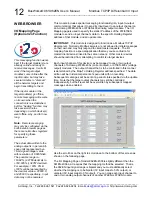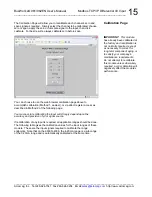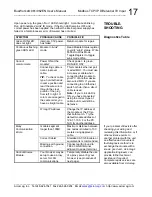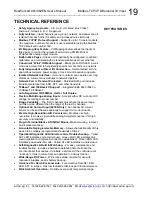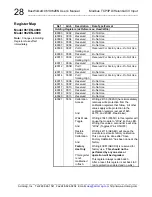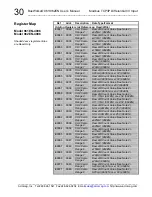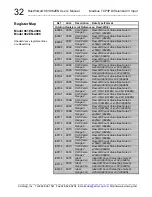
BusWorks® 961/962EN User’s Manual Modbus TCP/IP Differential I/V Input
__________________________________________________________________
_______________________________________________________________________________________
Acromag, Inc. Tel:248-624-1541 Fax:248-624-9234 Email:
http://www.acromag.com
22
A
Static IP Address
is as the name implies—static. That is, it is a unique IP
Address that is assigned by a service provider and never changes.
A
Dynamic IP Address
is an address that is temporarily assigned to a user
by a service provider each time a user connects.
A
Subnet
is a contiguous string of IP addresses. The first IP address in a
subnet is used to identify the subnet and usually addresses the server for the
subnet. The last IP address in a subnet is always used as a broadcast
address and anything sent to the last IP address of a subnet is sent to every
host on that subnet.
Subnets are further broken down into three size classes based on the 4
octets that make up the IP address. A Class A subnet is any subnet that
shares the first octet of the IP address. The remaining 3 octets of a Class A
subnet will define up to 16,777,214 possible IP addresses (2
24
– 2). A Class
B subnet shares the first two octets of an IP address (providing 2
16
– 2, or
65534 possible IP addresses). Class C subnets share the first 3 octets of an
IP address, giving 254 possible IP addresses. Recall that the first and last
IP addresses are always used as a network number and broadcast address
respectively, and this is why we subtract 2 from the total possible unique
addresses that are defined via the remaining octet(s).
For our example, the default IP address of this module is 128.1.1.100. If we
assume that this is a Class C network address (based on the default Class
C subnet mask of 255.255.255.0), then the first three numbers represent this
Class C network at address 128.1.1.0, the last number identifies a unique
host/node on this network (node 100) at address 128.1.1.100.
A
Subnet Mask
is used to determine which subnet an IP address belongs to.
The use of a subnet mask allows the network administrator to further divide
the host part of this address into two or more subnets. The subnet mask
flags the network address portion of the IP address, plus the bits of the host
part that are used for identifying the sub-network. By convention, the bits of
the mask that correspond to the sub-network address are all set to 1’s (it
would also work if the bits were set exactly as in the network address). It’s
called a mask because it can be used to identify the unique subnet to which
an IP address belongs to by performing a bitwise AND operation between
the mask itself, and the IP address, with the result being the sub-network
address, and the remaining bits the host or node address.
For our Example, if we wish to further divide this network into 14 subnets,
then the first 4 bits of the host address will be required to identify the
subnetwork (0110), then we would use “11111111.11111111.11111111.
11110000” as our subnet mask. This would effectively subdivide our Class
C network into 14 subnetworks of up to 14 possible nodes each.
With respect to the default settings of this module:
Subnet Mask 255.255.255.0 (11111111.11111111.11111111.00000000)
IP Address: 128.1.1.100 (10000000.00000001.00000001.01100100)
Subnet Address: 128.1.1.0 (1000000.00000001.00000001.00000000)
Subnetwork address 128.1.1.0 has 254 possible unique node addresses.
We are using node 100 of 254 possible for our module.
IP Addressing
Note that the first node
address (0) and node 10 are
typically reserved for servers
and should not be used. The
last node (255) is a broadcast
address. Node 100 is the
default address of this module.
Use of these node addresses
for any other purpose may
yield poor performance.





